It’s funny how places miles away seem more appealing than the ones nearer home. Despite passing David Livingstone’s Centre in Blantyre regularly, I had only visited it a few times, until one day I decided it was time pay another visit.
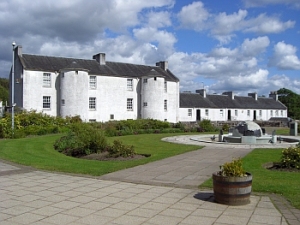
The Visitor Centre is a new building and contains pamphlets and books, as well as gifts and a coffee shop. Tickets are obtained there for the Museum, which is in Shuttle Row, where Dr Livingstone was born.
This whole building, which housed 23 families in David Livingstone’s time, is now devoted to his life and work.
It contains many of Dr Livingstone’s possessions including his diaries and journals, his maps of Africa and his navigational instruments, including sextant and compasses.
Dr Livingstone’s Medical Kit
As a doctor of medicine, he also had an extensive medical kit because of the illnesses and diseases in Africa. Malaria, caused by the bite from a mosquito was widespread and Dr Livingstone advocated the use of quinine to relieve the symptoms of malaria. (Narrative of an expedition to the Zambesi and its tributaries; and of the discovery of the Lakes Shirwa and Nyassa (1858-1864) – Chapter 3 – Page 88.)
Remedy for Malaria
His remedy for malaria was known as “rousers” as it could rouse those who were extremely weak and incapacitated, the recipe of which he details below:
“A remedy composed of from six to eight grains of resin of jalap, the same
of rhubarb, and three each of calomel and quinine, made up into four pills,
with tincture of cardamoms, usually relieved all the symptoms in five or six
hours. Four pills are a full dose for a man – one will suffice for a woman.
They received from our men the name of ‘rousers’ from their efficacy in
rousing up even those most prostrated. When their operation is delayed, a
desert-spoonful of Epsom salts should be given. Quinine after or during the
operation of the pills, in large doses every two or three hours, until deafness’
or cinchonism ensued, completed the cure.”
(Narrative of an expedition to the Zambesi and its tributaries; and of the discovery of the Lakes Shirwa and Nyassa (1858-1864) – Chapter 3 – Page 88.)
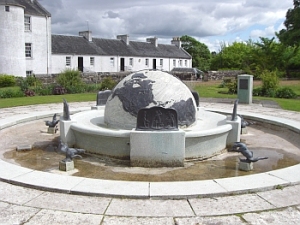
Dr Livingstone the Missionary
Dr Livingstone was also a religious man and had been brought up in the Church of Scotland, but left when he was 19 years old to join the Congregational Church. He had a good knowledge of the Scriptures and used the power of prayer to help him and others in time of need. He used his love of the Scriptures to teach others about Christianity.
Horrors of Slavery
He also spoke out about the horrors of slavery in Africa and campaigned for its abolition. He gives a graphic description of the horrors of slavery in an entry in his journal on 19th June, 1866:
“JUNE 19th, 1866. We passed a woman tied by the neck to a tree and dead ; the people of the country explained that she had been unable to keep up with the other slaves in a gang, and her master had determined that she should not become the property of anyone else if she recovered after resting for a time. I may mention here that we saw others tied up in a similar manner, and one lying in the path shot or stabbed, for she was in a pool of blood.
The explanation we got invariably was that the Arab who owned these victims was enraged at losing his money by the slaves becoming unable to. March, and vented his spleen by murdering them ; but I have nothing more than common report in support of attributing this enormity to the Arabs.”
(The Last Journals of David Livingstone in Central Africa From Eighteen Hundred)
Visiting David Livingstone’s Centre
The Centre is in Blantyre at the bottom of Station Road. It can be accessed by public transport or private car. It is situated in parkland. Prominent in the grounds is a statue of David Livingstone being attacked by a lion in the Mabotsa Valley in 1843. This magnificent bronze statue is worth a closer look. It
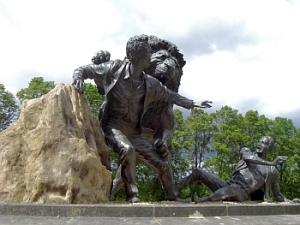
was designed and paid for oscar-winning animator Ray Harryhausen and his wife Diane, who is David Livingstone’s great-grand-daughter, in 2004.
The modern Visitor Centre and Museum are a short walk from the statue.
Livingstone Museum
The Museum is situated in the building in which the young David was born. It is on three floors and visitors work from the top down to the ground floor. Young David lived in one room in this building.
The top floor has many items from Dr Livingstone’s childhood including the room in which he was born, his christening shawl, a loom with a description of what life was like in the mills and some items from his travels in Africa. It also includes a copy of a map Dr Livingstone drew of the Trans Africa Expedition. The Consular Uniform given to him by Queen Victoria is also on display.
The middle floor has exhibits dedicated to Dr Livingstone’s missionary life and crusade against slavery. It also has a Dark Gallery which contains some powerful 3d images of Dr Livingstone in Africa and of his hour of death in 1874. It was designed by Charles d’Orville Pilkington Jackson (1887-1973)
Crusade Against Slavery
Dr livingstone’s crusade against slavery is also documented and many artifacts from the slave trade are on display including marchettes, shackles and whips, which show the horrific treatment endured by the slaves. Dr livingstone’s wife Mary is also given prominence and some of her personal possessions are also on display.
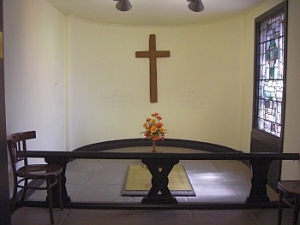
The ground floor has items relating to Dr Livingstone the explorer and as a medical doctor. Many of his medical instruments are on display including surgical instruments and medicines.
A cast of the arm which was broken by a lion in 1843 is also on display.
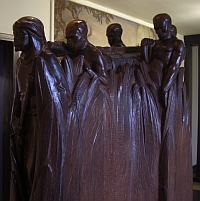
There are also copies of maps drawn by Dr livingstone and the navigational instruments he used including his sextant, compass, sundial and telescope.
The red shirt he was wearing when he met Henry Morton Stanley in 1871 is also on display. The shirt was made from cotton which originated in the Blantyre Mills where the young David worked.
The Last Journey Home
A magnificent carving by Charles d’Orville Pilkington Jackson (1887-1973) depicts the journey transporting Dr Livingstone’s body from Africa to England. The memorial in westminster Abbey where Dr Livingstone is buried is located in a small area laid out as a place of prayer with a stain-glass window providing some natural light.
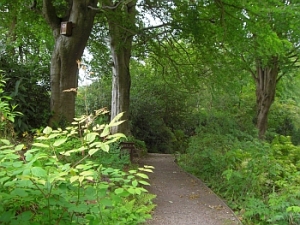
This signals the end of the tour of the Museum but there are other areas to explore including the gardens, which are home to many species of birds and wildlife.
NB: Some of Dr Livingstone’s books and journal can be read online. Links to these are listed below:
1. Narrative of an expedition to the Zambesi and its tributaries
and of the discovery of the Lakes Shirwa and Nyassa, 1858-1864
by David and Charles Livingstone. – http://openlibrary.org/books/OL6955469M/
2. The Last Journals of David Livingstone in Central Africa From Eighteen Hundred – http://www.readanybook.com/ebook/
Further Information: The David Livingstone Centre is maintained by the National Trust for Scotland.
Address: 165 Station Road, Blantyre, South Lanarkshire G72 9BY
Ordnance Survey Ref: NS695584